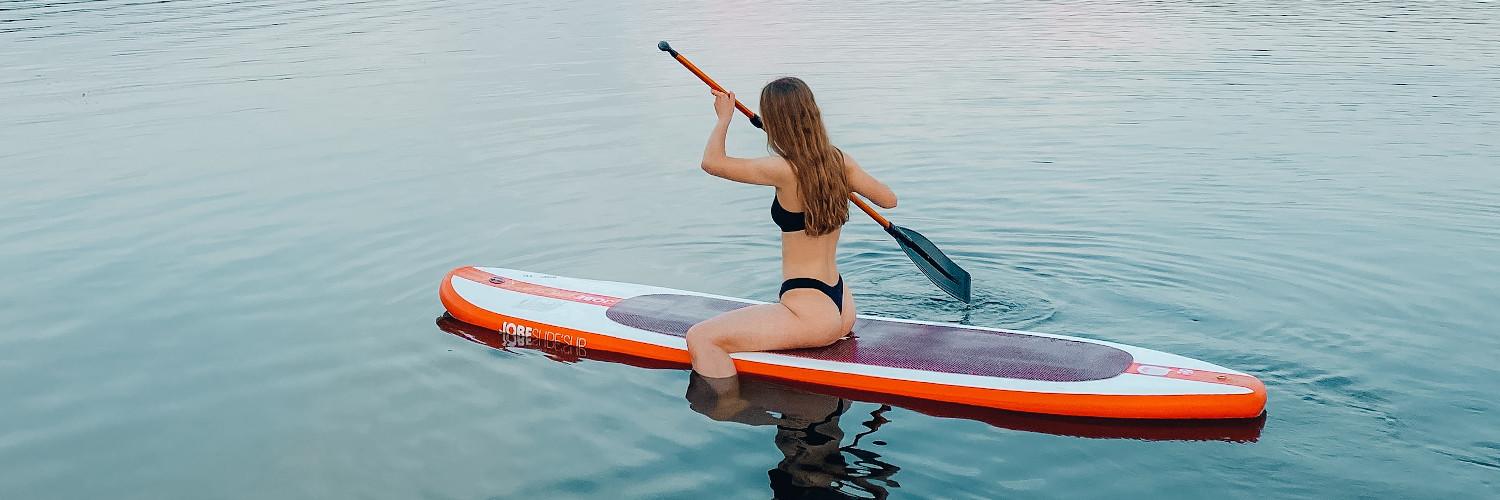Storing a stand-up paddleboard (SUP) efficiently and safely is a concern for many watersports enthusiasts. SUP hangers are an ideal solution, offering a way to keep boards off the ground, avoid damage, and save space. These hangers come in various designs, from simple hooks to adjustable straps, capable of securing the board to a wall or ceiling. They make storage in homes, garages, or retail spaces organized and accessible, preventing clutter and protecting the board’s structure and finish.
The variety of SUP hangers available on the market cater to different needs and preferences. Some users opt for heavy-duty wall hangers with significant load capacities, ensuring stability and support for even the heaviest boards. Others may find adjustable straps more suitable, as they can easily accommodate various board sizes and are often a more economical choice. The materials used in these hangers, whether steel or a durable form of plastic, are designed to withstand the weight of the board and resist wear from frequent use.
Choosing the right SUP hanger involves considering the specific storage space, frequency of use, and type of paddleboard. With options like wall-mounted racks and garage storage hooks, paddlers can find the right hanger to display their boards or tuck them away safely. As more people embrace the sport and the demand for efficient storage solutions rises, the availability of high-quality, reliable hangers is likely to expand, offering paddlers even more ways to care for their equipment.
Understanding SUP Hangers
Stand Up Paddle boarding (SUP) enthusiasts require robust storage solutions such as SUP hangers or racks. These devices provide a secure way to store boards while saving space.
Historical Significance
SUP hangers have evolved from simple hooks to sophisticated storage systems, mirroring the growth of stand up paddle boarding. The aim has always been the same: to safeguard and display the paddle board when not in use, and to prevent damage from improper storage.
Types and Styles
SUP hangers come in various types and styles, each designed with specific features to accommodate different needs and spaces.
- Wall Racks: Wall-mounted options, like the Paddle Board Junction hanger, typically span around 11 inches from the wall and can support weights up to 50 lbs.
- Double Racks: For multiple boards, products like the StoreYourBoard Double SUP Wall Rack cater to users with more than one SUP.
- Weight Capacity: Some wall hangers, such as the RAD Sportz Wall Hanger Pro, can support up to 125 pounds, indicating they can hold larger and often more advanced boards.
Each type of SUP hanger or rack utilizes different materials and attachment methods to ensure a secure hold for the stand up paddle boards they are designed to store. Users choose based on their storage needs, the number of boards, the weight of their SUPs, and the available installation space.
Key Features of SUP Hangers
SUP hangers are designed for ease of use and durability. They provide efficient wall storage solutions for paddle boards, ensuring they are securely mounted and accessible.
Design Elements
SUP hangers often include adjustable features to accommodate various paddle board sizes. They usually incorporate tough nylon straps or secure webbing that hugs the contours of the paddle boards, coupled with heavy-duty buckles that ensure the hangers can be tightened for a custom fit. The strap length is often modifiable, allowing for varying board widths, which makes the storage solution flexible and adaptable.
Material Strength
When it comes to material, galvanized steel is commonly used for its resistance to rust and overall durability. SUP hangers may also feature steel J-hooks, which are coated with a protective layer to prevent scratches on the paddle board surfaces during storage. The load capacity of these hangers can be substantial, with some models capable of supporting up to 125 lbs, indicating their heavy-duty build. This strength ensures that the gear remains safely anchored to the wall.
Installation Process
The installation process of a spring hanger is critical for the secure and efficient support of piping systems. Ensuring that the hardware is correctly installed, adherence to instructions is followed, and mounting holes are utilized properly, will lead to successful implementation.
Preparing for Installation
Prior to beginning the installation, one must ensure all needed materials, such as screws and hardware, are on hand and that the storage and handling of these materials have been in line with manufacturer’s guidelines. The exact specifications for installation should be taken from the supplier’s instructions. The area of installation should be clear of obstructions and the structural support above should be capable of carrying the load of the spring hanger along with the pipes.
Mounting Techniques
When mounting the spring hanger, it’s essential to attach the hardware in the correct order. First, the rod assembly is connected to the load column; afterwards, the other end of the rods should be attached to the structural support ensuring that the spring cans are suspended correctly. Mounting holes must be pre-drilled or pre-existing at the correct locations to accommodate the hanger assembly securely. Care should be taken to ensure that the mounting technique aligns with the type of spring hanger being installed, whether it be a type that supports a beam between springs or a rod hanger assembly that secures to overhead structures.
SUP Hanger Selection Guide
When selecting a SUP hanger for paddle boards, consumers should pay close attention to weight capacity and size compatibility, as well as price range, for optimal storage solutions.
Size and Weight Considerations
The primary factor in choosing a SUP hanger is the weight capacity. Hangers vary in strength and can support weights ranging from 50 lbs to several hundreds of pounds. It is vital to select a hanger that exceeds the weight of the paddle board to ensure safety and longevity. The hanger’s dimensions are equally important; they must accommodate the size of the SUP board, specifically the width, to guarantee a secure fit. Manufacturers often provide a size guide ensuring compatibility with various board sizes:
- Max Board Width: How wide the SUP can be to fit the rack.
- Weight Limit: Not to exceed for safety and stability.
For example, some wall hangers are explicitly designed to span wide enough to hold boards up to 155mm in width, and heavy-duty materials are often used to assure the hanger can bear the weight of the board seamlessly.
Comparing Prices
Price is a secondary, yet important consideration. SUP hangers can range from budget-friendly options to more expensive models that offer additional features like enhanced protection or double board storage. Here is a general price guide for consumers:
| Price Range | Storage Type | Capacity |
|---|---|---|
| $ | Single SUP wall hanger | 1 Board up to 50 lbs |
| $ | Double SUP wall rack | 2 Boards, weight varies based on design |
Consumers should balance the cost against features like materials used, load capabilities, and the amount of storage space the hanger uses. A higher-priced hanger may offer better durability or more board storage, while simpler designs will be more cost-effective for those with minimal space or a single board to store.
SUP Storage Solutions
Effective SUP storage solutions are pivotal for protecting the integrity of your boards and maximizing the available space in your home or garage. These include a range of racks and accessories designed to optimize both indoor and outdoor storage areas.
Maximizing Space Utilization
When floor space is at a premium, ceiling racks offer a great way to keep SUP boards out of the way. These systems can be mounted indoors and use the overhead space that is often underutilized. They typically come in single and double board configurations to suit different storage needs. For those who need to store multiple boards, wall-mounted racks can transform vertical spaces into efficient storage areas. These racks are ideal for both indoor and outdoor use ensuring that boards remain safe, secure, and readily accessible.
Innovative Storage Accessories
In addition to racks, a series of innovative storage accessories can further enhance SUP organization. A popular choice is the universal paddle holder. This accessory ensures that paddles are neatly stored alongside their boards, providing convenience and order. For versatile storage solutions, adjustable racks can be transformed to hold not just SUPs but also kayaks and canoes, exemplified by the versatility of the kayak hanger. These accessories are designed to withstand various conditions, endorsing their suitability for both indoor and outdoor environments. They are instrumental in creating a clutter-free and systematized storage space for SUP enthusiasts.
Care and Maintenance of SUP Hangers
Proper care and maintenance of SUP hangers are crucial for ensuring the safety and longevity of both the hangers and the paddle boards they hold. They must be durable to withstand the weight and frequent use, and routine checks along with steps to ensure long-term durability are essential.
Routine Checks
One should conduct regular inspections of the SUP hangers to ensure their structural integrity. Heavy-duty webbing should be checked for fraying, and the hangers' mounting points must be secure and not show signs of wear.
- Inspect for any visible damage or wear
- Ensure screws and bolts are tight
- Look for signs of rust on metal components
- Check the webbing for tears or excessive stretching
Long-Term Durability
For longevity, it’s important to choose SUP hangers that are constructed with strength in mind, often indicated by the ability to support a certain weight limit without deforming. Periodic maintenance is also vital.
- Clean hangers regularly to prevent buildup of dirt or salt
- Replace any corroded or weakened parts immediately
- Use corrosion-resistant materials in areas with high humidity or salt exposure
Customer Insights
Customer insights for SUP (Stand Up Paddleboard) hangers are essential in guiding manufacturers towards product development that aligns with the user demands. Insights are often derived from meticulous analysis of consumer feedback, which sheds light on preferences and pain points regarding SUP storage solutions.
Analyzing Reviews
Consumers frequently utilize online reviews to express their satisfaction or concerns with SUP hangers. Manufacturers should monitor these reviews carefully, as they provide direct voice-of-the-customer data. Key points that often emerge from reviews include:
- Durability: How well do the hangers withstand the weight of the SUP and the test of time?
- Ease of Installation: Are the instructions clear and is the installation process straightforward?
- Security: Does the hanger securely hold the gear without risk of falling or damage?
Through a systematic assessment of this feedback, brands can pinpoint aspects of their product that work well and those that need refinement.
Personalized Choices
The prominence of personalized gear storage is evident in the variety of SUP hangers available on the market. Customer preferences tend towards options that offer adaptability and cater to different spaces and board sizes. Highlighted features that align with individual needs include:
- Adjustability: The ability to adjust the hanger to fit various board widths and weights.
- Material: The preference for materials that do not damage the surface of the SUP.
- Space Efficiency: A design that maximizes space, suitable for garage storage or display purposes.
By incorporating these features, SUP hanger producers can cater to a broader spectrum of paddlers seeking tailored storage solutions.
SUP Hanger Safety Tips
When utilizing SUP hangers, safety should be of utmost priority to prevent accidents during the loading and unloading process and to ensure the secure storage of stand-up paddleboards.
Loading and Unloading Precautions
Loading and unloading a stand-up paddleboard onto a SUP hanger can be risky if not done properly. Individuals should always:
- Lift using their legs, not their back, to avoid injury.
- Secure the paddleboard from both sides to ensure balance.
- Confirm that the path is clear of obstacles to avoid tripping or collision.
- Place the board gently onto the hanger without letting it drop.
Security Measures
To prevent theft or accidental dislodging of the stand-up paddleboard from the SUP hanger, the following security measures are necessary:
- Utilize locking mechanisms if available.
- Position the SUP hanger in a well-lit area where activity deters potential thieves.
- Regularly inspect the hanger for any signs of wear and tear that could weaken its hold.
Additional Considerations
When selecting a SUP hanger, buyers should not only consider the immediate convenience but also the broader implications of their choice, including environmental impact and how the hanger serves various use cases.
Environmental Impact
Choosing a SUP hanger can have environmental repercussions. For instance, selecting hangers made from sustainable materials can reduce the ecological footprint. It’s also prudent for consumers to consider the longevity of the hanger. A durable hanger made from quality materials like marine-grade components will not need to be replaced as often, thereby diminishing waste. Furthermore, environmentally conscious users should consider if the hanger can accommodate inflatable SUPs, which may require a different support system due to their different structure compared to rigid boards.
Adaptable Use Cases
SUP hangers should offer flexibility to adjust to various situations and storage needs. The ability to store paddles alongside the board is critical for maintaining organization and convenience. An adaptable hanger should cater to both singular and combination storage requirements, meaning it should be able to securely support one or multiple items, including kayaks or SUP boards. Users with inflatable SUPs should look for a hanger system that provides secure straps or supports that account for the unique needs of storing inflatable equipment. A feature that can be particularly useful in adapting to various use cases is the ability to configure the hanger for vertical or horizontal storage, which can help users maximize their space effectively.
Conclusion
In selecting an SUP hanger, consumers prioritize quality and affordability. The market offers various styles designed to meet an array of storage needs. Most hangers provide an extension of space within homes or garages, and the mounting style—whether on walls or ceilings—matters for efficient space utilization.
- Quality is evident in hangers that sustain the weight of boards without bending or breaking.
- Affordability ensures that every paddleboard enthusiast can find a storage solution within their budget.
- Style becomes a consideration for those wishing to display their boards as part of their home décor.
- Wood is a favored material for its durability and aesthetic appeal, often finished with oils for added resilience.
The purchaser should seek a balance between these factors to find a suitable SUP hanger. It is important that the chosen hanger not only provides secure storage but also complements the owner’s space and lifestyle.





